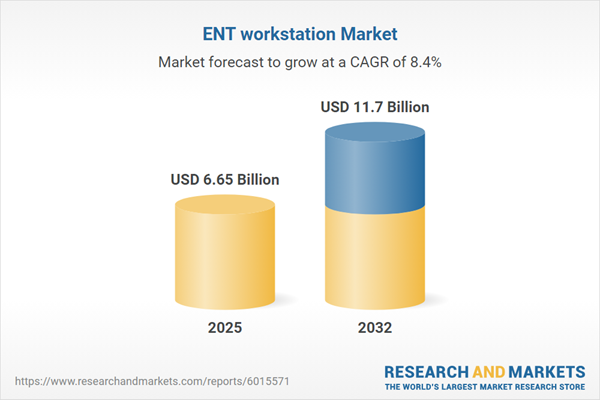Speak directly to the analyst to clarify any post sales queries you may have.
The ENT workstation market is advancing rapidly as healthcare leaders seek integrated, secure, and high-performance solutions to deliver streamlined workflows and clinical accuracy. Evolving technology and new demands for regulatory compliance are influencing purchasing strategies and unlocking fresh opportunities across provider segments.
Market Snapshot: ENT Workstation Market Maintains Robust Growth
The ENT workstation market grew from USD 6.16 billion in 2024 to USD 6.65 billion in 2025, with a projected CAGR of 8.35%, reaching USD 11.70 billion by 2032. Investment in advanced surgical technologies, enhanced visualization tools, and ongoing emphasis on user-focused designs are key growth drivers. Healthcare providers are investing in upgrades to meet changing regulations and enable digital integration. A commitment to technology-driven transformation is raising clinical standards and accelerating adoption across all regions in the global healthcare sector.
Scope & Segmentation of the ENT Workstation Market
This report offers detailed market segmentation, supporting senior decision-makers with targeted analysis and clear direction for investment, procurement, and operational priorities in the global ENT workstation market:
- End User: Ambulatory surgical centers, hospitals, ENT clinics, and research institutes—each representing unique operational requirements and procurement behaviors.
- Product Type: Diagnostic systems with audiometry and olfactometry, a full suite of 3D and optical endoscopes, high-resolution imaging tools, and advanced surgical instruments.
- Application: Solutions for diagnostics, patient monitoring, clinical research, and a range of surgical interventions targeting otolaryngologic conditions.
- Technology: Integration of 3D, optical, and video endoscopic techniques using monoscopic and stereoscopic imaging, with fiber-optic and rod-lens advancements enabling higher clinical precision.
- Modality: Both reusable and single-use flexible or rigid endoscopes, allowing facilities to match device choices to infection control protocols and workflow needs.
- Distribution Channel: Multiple pathways, including direct sales, medical dealers, regional distributors, e-commerce, and manufacturer-led channels, provide procurement flexibility for institutions of varying scale.
- Regions: Americas, Europe, Middle East & Africa, Asia-Pacific, with notable demand growth and access developments in countries such as China, India, and Japan.
- Key Companies: Competitive landscape includes Olympus Corporation, KARL STORZ, Richard Wolf, Siemens Healthineers, Stryker, Drägerwerk, Hoya, Baxter International, Medtronic, and GE HealthCare Technologies.
Key Takeaways for Senior Decision-Makers in ENT Workstation Markets
- Digitally integrated solutions are streamlining processes and reducing manual steps, thus supporting faster and more consistent clinical diagnostics and improving team coordination.
- Advanced visualization features in device portfolios enable healthcare providers to increase procedural scope, facilitating minimally invasive care and fostering better patient outcomes.
- Manufacturers are adapting workstation solutions to the unique needs of clinics, hospitals, and research settings, helping organizations optimize operational productivity and resource allocation.
- Modular design concepts and user-friendly interfaces are accelerating adoption rates, especially in diverse regional markets, thanks to straightforward integration with existing infrastructure.
- The adoption of artificial intelligence, machine learning, and telemedicine expands access to ENT care, supporting remote consultation and real-time diagnostics for underserved populations.
- Educational tools, technical support, and adaptable financing are increasing technology uptake, especially as institutions seek scalable solutions within mid-sized and emerging care markets.
Tariff Impact: Addressing New Supply Chain Pressures
Recent adjustments in US tariffs have driven up the cost of essential ENT workstation components, such as precision optics and imaging sensors. This has led manufacturers to localize production, broaden their supplier base, and revise procurement strategies to manage expenses. In response, healthcare organizations are adopting group purchasing and collaborative procurement to maintain budgets and consistent device access. Building resilient supply chains and embracing flexible procurement are now central to ensuring operational continuity and future technology readiness in ENT workstation adoption.
Methodology & Data Sources
Primary interviews with ENT clinicians, healthcare procurement professionals, and industry leaders form the foundation of this research. These insights are strengthened by regulatory documentation, peer-reviewed literature, comprehensive market studies, and supplemental survey results alongside end-to-end value-chain mapping.
Why This Report Matters for Decision-Makers
- Empowers stakeholders to evaluate investments and shape procurement strategies that align with clinical and operational priorities worldwide.
- Clarifies shifts in technology, regulatory frameworks, and supply chain models, facilitating informed supplier selection and compliance planning.
- Supports confident action in navigating reimbursement, regulatory, and operational complexities by providing proven frameworks and actionable insights.
Conclusion
This report delivers objective analysis to inform strategic ENT technology investments. The insights available here enhance competitive positioning and improve care delivery in a changing healthcare landscape.
Additional Product Information:
- Purchase of this report includes 1 year online access with quarterly updates.
- This report can be updated on request. Please contact our Customer Experience team using the Ask a Question widget on our website.
Table of Contents
3. Executive Summary
4. Market Overview
7. Cumulative Impact of Artificial Intelligence 2025
Companies Mentioned
The companies profiled in this ENT workstation market report include:- Olympus Corporation
- KARL STORZ GmbH & Co. KG
- Richard Wolf GmbH
- Siemens Healthineers AG
- Stryker Corporation
- Drägerwerk AG & Co. KGaA
- Hoya Corporation
- Baxter International Inc.
- Medtronic plc
- GE HealthCare Technologies Inc.
Table Information
| Report Attribute | Details |
|---|---|
| No. of Pages | 190 |
| Published | October 2025 |
| Forecast Period | 2025 - 2032 |
| Estimated Market Value ( USD | $ 6.65 Billion |
| Forecasted Market Value ( USD | $ 11.7 Billion |
| Compound Annual Growth Rate | 8.3% |
| Regions Covered | Global |
| No. of Companies Mentioned | 11 |









